-
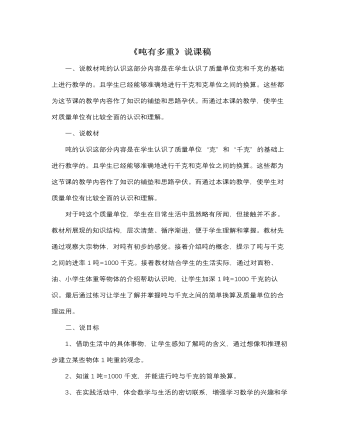
北师大版小学数学三年级下册《吨有多重》说课稿
一、说教材吨的认识这部分内容是在学生认识了质量单位“克”和“千克”的基础上进行教学的。且学生已经能够准确地进行千克和克单位之间的换算。这些都为这节课的教学内容作了知识的铺垫和思路孕伏。而通过本课的教学,使学生对质量单位有比较全面的认识和理解。对于吨这个质量单位,学生在日常生活中虽然略有所闻,但接触并不多。教材所展现的知识结构,层次清楚、循序渐进,便于学生理解和掌握。教材先通过观察大宗物体,对吨有初步的感觉。接着介绍吨的概念,提示了吨与千克之间的进率1吨=1000千克。接着教材结合学生的生活实际,通过对面粉、油、小学生体重等物体的介绍帮助认识吨,让学生加深1吨=1000千克的认识。最后通过练习让学生了解并掌握吨与千克之间的简单换算及质量单位的合理运用。
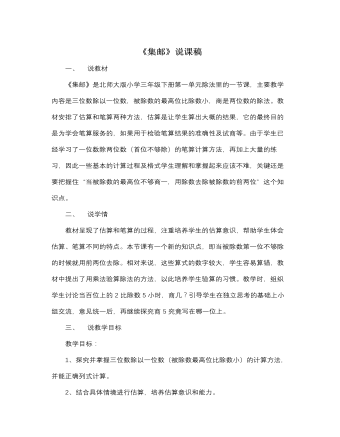
北师大版小学数学三年级下册《集邮》说课稿
《集邮》是北师大版小学三年级下册第一单元除法里的一节课,主要教学内容是三位数除以一位数,被除数的最高位比除数小,商是两位数的除法。教材安排了估算和笔算两种方法,估算是让学生算出大概的结果,它的最终目的是为学会笔算服务的,如果用于检验笔算结果的准确性及试商等。由于学生已经学习了一位数除两位数(首位不够除)的笔算计算方法,再加上大量的练习,因此一些基本的计算过程及格式学生理解和掌握起来应该不难,关键还是要把握住“当被除数的最高位不够商一,用除数去除被除数的前两位”这个知识点。二、说学情教材呈现了估算和笔算的过程,注重培养学生的估算意识,帮助学生体会估算、笔算不同的特点。本节课有一个新的知识点,即当被除数第一位不够除的时候就用前两位去除。相对来说,这些算式的数字较大,学生容易算错,教材中提出了用乘法验算除法的方法,以此培养学生验算的习惯。
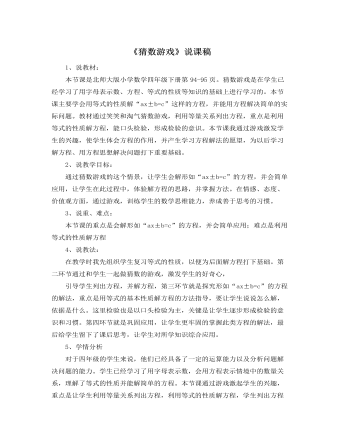
北师大版小学数学四年级下册《猜数游戏》说课稿
1、说教材:本节课是北师大版小学数学四年级下册第94-95页。猜数游戏是在学生已经学习了用字母表示数、方程、等式的性质等知识的基础上进行学习的。本节课主要学会用等式的性质解“ax±b=c”这样的方程,并能用方程解决简单的实际问题。教材通过笑笑和淘气猜数游戏,利用等量关系列出方程,重点是利用等式的性质解方程,能口头检验,形成检验的意识。本节课我通过游戏激发学生的兴趣,使学生体会方程的作用,并产生学习方程解法的愿望,为以后学习解方程、用方程思想解决问题打下重要基础。2、说教学目标:通过猜数游戏的这个情景,让学生会解形如“ax±b=c”的方程,并会简单应用,让学生在此过程中,体验解方程的思路,并掌握方法。在情感、态度、价值观方面,通过游戏,训练学生的数学思维能力,养成善于思考的习惯。3、说重、难点:本节课的重点是会解形如“ax±b=c”的方程,并会简单应用;难点是利用等式的性质解方程
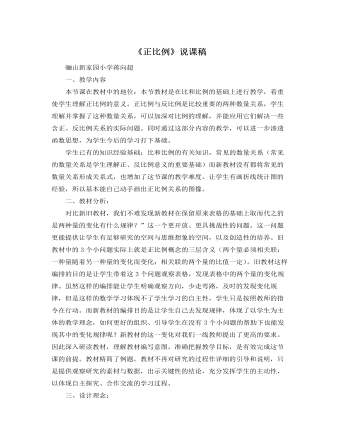
北师大版小学数学六年级下册《正比例》说课稿
{二}、努力实现扶与放的和谐统一,共同构建有效课堂。学生能自己解决的决不包办代替:学生可能完成的,充分相信学生,发挥自主探索与合作交流的优点,让学生有一个充分体验成功展示自我的舞台;学生有困难的,给予适当引导,拒绝无效探究,提高课堂效率。四、教学目标:基于对教材的理解和分析,我将该节课的教学目标定位为:1、帮助学生理解正比例的意义。用字母表示变量之间的关系,加深对正比例的认识。2、通过观察、比较、判断、归纳等方法,培养学生用事物相互联系和发展变化的观点来分析问题,使学生能够根据正比例的意义判断两种量是不是成正比例。3、学生在自主探索,合作交流中获得积极的数学情感体验,得到必要的数学思维训练。
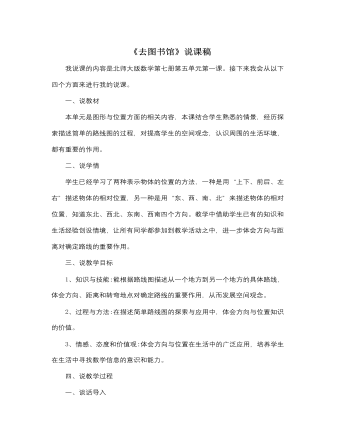
北师大版小学数学四年级上册《去图书馆》说课稿
一、说教材本单元是图形与位置方面的相关内容,本课结合学生熟悉的情景,经历探索描述简单的路线图的过程,对提高学生的空间观念,认识周围的生活环境,都有重要的作用。二、说学情学生已经学习了两种表示物体的位置的方法,一种是用“上下、前后、左右”描述物体的相对位置,另一种是用“东、西、南、北”来描述物体的相对位置,知道东北、西北、东南、西南四个方向。教学中借助学生已有的知识和生活经验创设情境,让所有同学都参加到教学活动之中,进一步体会方向与距离对确定路线的重要作用。三、说教学目标1、知识与技能:能根据路线图描述从一个地方到另一个地方的具体路线,体会方向、距离和转弯地点对确定路线的重要作用,从而发展空间观念。2、过程与方法:在描述简单路线图的探索与应用中,体会方向与位置知识的价值。3、情感、态度和价值观:体会方向与位置在生活中的广泛应用,培养学生在生活中寻找数学信息的意识和能力。
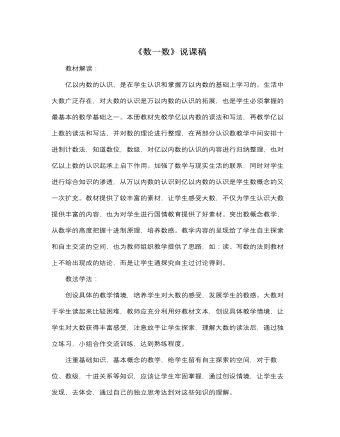
北师大版小学数学四年级上册《数一数》说课稿
亿以内数的认识,是在学生认识和掌握万以内数的基础上学习的。生活中大数广泛存在,对大数的认识是万以内数的认识的拓展,也是学生必须掌握的最基本的数学基础之一。本册教材先教学亿以内数的读法和写法,再教学亿以上数的读法和写法,并对数的理论进行整理,在两部分认识数教学中间安排十进制计数法,知道数位,数级,对亿以内数的认识的内容进行归纳整理,也对亿以上数的认识起承上启下作用。加强了数学与现实生活的联系,同时对学生进行综合知识的渗透,从万以内数的认识到亿以内数的认识是学生数概念的又一次扩充。教材提供了较丰富的素材,让学生感受大数,不仅为学生认识大数提供丰富的内容,也为对学生进行国情教育提供了好素材。突出数概念教学,从数学的高度把握十进制原理,培养数感。教学内容的呈现给了学生自主探索和自主交流的空间,也为教师组织教学提供了思路,如:读、写数的法则教材上不给出现成的结论,而是让学生通探究自主过讨论得到。

北师大版小学数学四年级上册《正负数》说课稿
二、说教学目标教学目标是一堂课的中心任务,所有教学环节都是为此服务的,课程标准指出:数学教学不仅要考虑数学自身的特点,更应遵循学生学习数学的心理规律??使学生获得对数学理解的同时,在思维能力、情感态度与价值观等方面都得到进步和发展。根据这一要求和本节教学内容,并结合学生的实际情况,本节课我确定如下学习目标:1、知识与技能在熟悉的生活情景中,进一步体会负数的意义;会用负数表示一些日常生活中的问题,知道正负可以相互抵消。2、过程与方法本节课以小组合作学习为主,让学生利用导学案自学,再对学、群学,最后在班里进行展示。整节课都是学生自主学习,积极探索的一个过程。3、情感、态度与价值观经历独学、交流、合作、展示等一系列活动,通过生生、师生互动获得良好的情感体验,同时让学生感受到了数学在生活中的应用。依据这样的教学目标,再结合学生的年龄特点,我运用了浅显易懂的儿童语言制定了导学案上的学习目标。
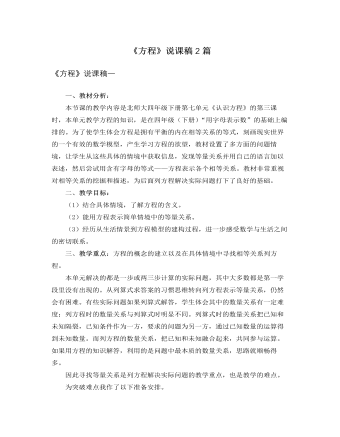
北师大版小学数学四年级下册《方程》说课稿2篇
3、变换角度,深入思考第三幅情境图隐含着多样的等量关系,也正是引发学生数学思考的最佳情境。根据学生认识的深入程度,可适当让学生体会到等式的“值等”和“意等”,并放手让学生探究,根据不同的认识找到不同的等量关系,列出等量关系不同的同解方程。在教学中,先引导孩子发现情境中的基本相等关系:2瓶水的水量+一杯水的水量=一壶水的水量,并且列出等式2z+200=2000,在此基础上,再引导孩子发现其他的等量关系。在这一过程中,充分激发孩子探求知识的欲望,调动孩子思考的主动性和灵活性,从而找到多样化的等量关系,并进一步提高孩子解决数学问题的能力。4、建立概念,判断巩固在前面教学的基础上总结、抽象出方程的含义。通过三道例题的简洁数学式子表达,让小组合作寻找他们的共同特点,从而建立方程的概念。“含有未知数”与“等式”是方程概念的两点最重要的内涵。并通过“练一练”让学生直接找出方程。
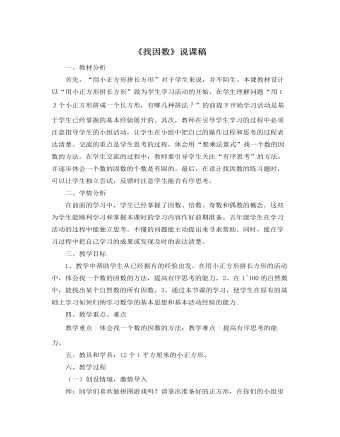
北师大版小学数学五年级上册《找因数》说课稿
【设计意图:让学生在操作、探索的基础上,组内交流想法,再在班内交流汇报,让学生的语言得到相互交流、碰撞,从而不断激发学生的思维火花。】师:你能把这些摆法用算式写出来吗?(学生独立写出算式并汇报)依学生汇报板书:1×12=122×6=1212×1=126×2=123×4=124×3=12师:请同学们观察一下,哪两道算式的因数一样?学生观察算式,找出因数一样的算式。师:那么,这6个算式最少能用几种算式表示出来?引导学生说出能用3种方法表示,这三种方法是:1×12=122×6=123×4=12,并指明算式一样时选择其中一种说出来。板书:12=1×12=2×6=3×4师:同学们观察一下,12的因数有哪几个?(学生说出12的因数有:1、12、2、6、3、4。)师:拼长方形与找因数有什么关系呢?(指名学生说一说)师:根据刚才的操作交流,请同学们说一说怎样找一个数的因数呢?(学生思考片刻后汇报,可以组内交流。)引导学生说出:用乘法思路想,看哪两个数相乘得12,然后一对一对找出来。
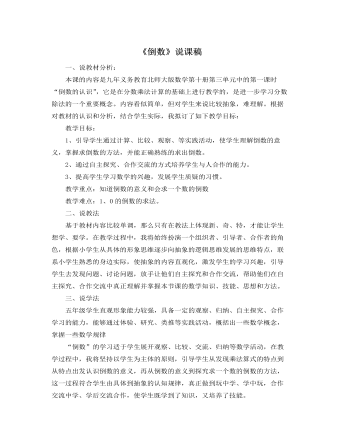
北师大版小学数学五年级下册《倒数》说课稿
教学目标:1、引导学生通过计算、比较、观察、等实践活动,使学生理解倒数的意义,掌握求倒数的方法,并能正确熟练的求出倒数。2、通过自主探究、合作交流的方式培养学生与人合作的能力。3、提高学生学习数学的兴趣,发展学生质疑的习惯。教学重点:知道倒数的意义和会求一个数的倒数教学难点:1、0的倒数的求法。二、说教法基于教材内容比较单调,那么只有在教法上体现新、奇、特,才能让学生想学、要学。在教学过程中,我将始终扮演一个组织者、引导者、合作者的角色,根据小学生从具体的形象思维逐步向抽象的逻辑思维发展的思维特点,联系小学生熟悉的身边实际,使抽象的内容直观化,激发学生的学习兴趣,引导学生去发现问题、讨论问题,放手让他们自主探究和合作交流,帮助他们在自主探究、合作交流中真正理解并掌握本节课的数学知识、技能、思想和方法。
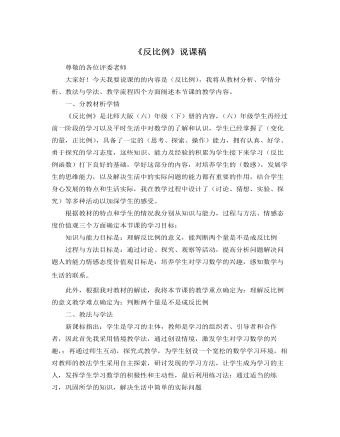
北师大版小学数学六年级下册《反比例》说课稿
知识与能力目标是:理解反比例的意义,能判断两个量是不是成反比例过程与方法目标是:通过讨论、探究、观察等活动,提高分析问题解决问题人的能力情感态度价值观目标是:培养学生对学习数学的兴趣,感知数学与生活的联系。此外,根据我对教材的解读,我将本节课的教学重点确定为:理解反比例的意义教学难点确定为:判断两个量是不是成反比例二、教法与学法新课标指出:学生是学习的主体,教师是学习的组织者、引导者和合作者,因此首先我采用情境教学法,通过创设情境,激发学生对学习数学的兴趣,;再通过师生互动,探究式教学,为学生创设一个宽松的数学学习环境,相对教师的教法学生采用自主探索,研讨发现的学习方法,让学生成为学习的主人,发挥学生学习数学的积极性和主动性,最后利用练习法:通过适当的练习,巩固所学的知识,解决生活中简单的实际问题
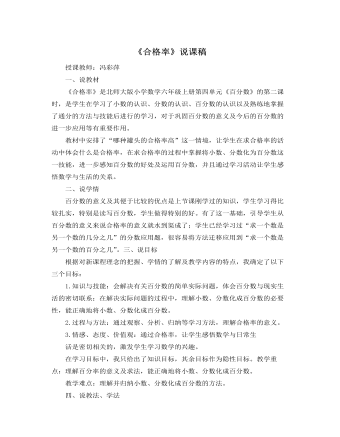
北师大版小学数学六年级上册《合格率》说课稿
四、说教法、学法我在教学中主要采用的教学方法是先学后教中的“两学两教”。辅之以多媒体教学手段(主要通过微课视频的观看学习)。本课学生的学习方法主要有:自主发现法、合作交流法、自学尝试法等。1.学生在自主探究解答例题,求两种品牌罐头的合格率时,主要采用自学尝试法,根据知识的迁移,学生能够正确求出产品合格率。2.在总结小数、分数化成百分数的方法时,学生主要采用自主发现,合作交流的方法。首先让学生观察例题板书,想一想怎样把小数、分数化成百分数,采用了“兵教兵”的方法,达到了人人参与的目的。当然,由于学生所处的文化环境,家庭背景和自身思维方式的不同,不同的学生所采用的方法也不尽相同,作为教师要尊重学生的选择,允许学生用自己喜欢的方式学习数学。五、说教学过程
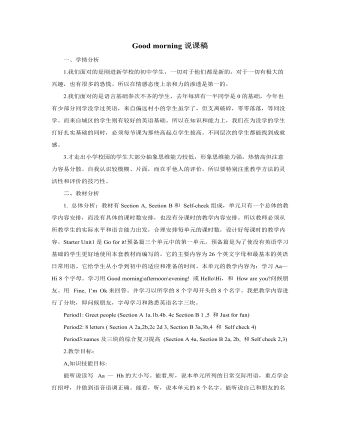
人教版新目标初中英语七年级上册Good morning说课稿
1.课堂活动中的竞赛制:以记奖评优的形式无声的评价每一个活动,包括个体和小群体。在第一课时评最佳演员和导演奖,第二课时评最佳团体奖,既节约时间又明确有效。使学生能提高语言质量,增强参与意识,提高学习兴趣。2. 教师课堂上语言、表情激励制:在课堂活动中教师要乐于 、善于用激励性语言。从good, super, smart, excellent , great ,wonderful等,用微笑,皱眉,摇头、点头等身体语言对于学生的评价是方便又有效的途径。3.课后作业评价:口头作业在第二天课堂上表演,接受全体同学的评价。笔头作业有教师批阅,以评语的方式出现。优秀作业予以展出或交流。积极地肯定和鼓励学生是我们评价的重要目的之一。4.单元结束后综合性评价:除了笔试以外,也可以根据学生实际开展丰富的活动,如:调查报告、小品表演、专题演讲等。
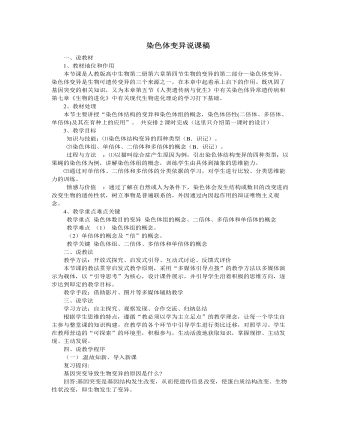
人教版高中生物必修2染色体变异说课稿
四、说教学程序(一).温故知新、导入新课复习提问:基因突变导致生物变异的原因是什么?回答:基因突变是基因结构发生改变,从而使遗传信息改变,使蛋白质结构改变、生物性状改变,即生物发生了变异。那么,基因是什么?它和染色体又有何关系?回答:基因是有遗传效应的DNA片断,染色体是DNA的载体,基因在染色体上呈线形排列。引出新知:对于一个生物体来说,正常情况下,其染色体的结构和数量都是稳定的。但在自然条件或人为因素的影响下,染色体的结构和数量均会发生改变,从而导致生物性状的改变,这就属于染色体变异。(二).把握重点、突破难点重点的把握:1、染色体结构的变异播放影片:猫叫综合征幼儿。让学生观察: 患儿哭声轻、音调高,很像猫叫。教师补充: 患儿的征状---两眼较低、耳位低下,存在着严重的智力障碍。阐述病因---染色体片段缺失
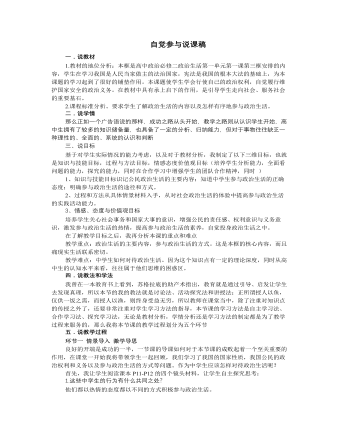
人教版高中政治必修2自觉参与说课稿
1.必须明确政治生活的作用 (政治生活与经济生活、文化生活是相辅相成的。政治生活直接影响到人民民主的实现程度,影响全体人民利益,也会影响我们的经济生活、文化生活。)2.需要学习政治知识 (5个有助于)3.需要参加政治实践活动。 (参加政治实践的途径;参加政治实践的意义)(通过情景问题,形成学生如何参与政治生活的方法;通过解决问题,培养学生解决问题的能力和发散思维的能力。)环节四 课堂小结 巩固知识本节课我采用线索性的板书,整个知识结构一目了然,为了充分发挥学生在课堂的主体地位,我将课堂小结交由学生完成,请学生根据课堂学习的内容,结合我的板书设计来进行小结,以此来帮助教师在第一时间掌握学生学习信息的反馈,同时培养学生归纳分析能力、概括能力。

人教版高中英语必修4Body Language说课稿4篇
Textbook: Senior English for China (Book 4), by Liu Daoyi Time Allotment: 1 period (40 minutes)Date: March 20, 2014Teaching aids: blackboard, Multi-media, Power Point, chalk I. Text Analysis (教材分析)This unit is about body language, and the text selected in the reading part demonstrates the difference and similarity of body language in many parts of the world. Through learning this passage, students are required to raise their awareness of using body language in different parts of the world. As body language is closely related to our daily life, it is easy to arouse students’ interest in learning this text. Reading skills and speaking training are designed around the text.II. Teaching Objectives (教学目标)By the end of the lesson, students will be able to:1. Language Skill Objective(语言技能目标): develop reading ability (skimming and scanning)as well as speaking ability.2. Cultural Knowledge Objective(文化知识目标): know about the cultural differences of using body language.3. Affective Objective(情感目标): increase students’ awareness of using body language correctly in different cultures. III.Teaching Focuses and Difficulties(教学重点和难点)1. Teaching Focuses(教学重点): the difference and similarity of body language in many parts of the world.2. Teaching Difficulties(教学难点): develop students’ reading abilities of skimming and scanning and ask the students to show their opinions with fluent English.

人教版高中英语必修1Nelson Mandela--A Modern Hero说课稿
In this step, give students a few minutes to read the passage . While they are reading, I will write some key words of the text on the blackboard. Then ask students to retell the passage according to the key words.By retelling, students can improve their ability of language organization and have an overall understanding of the article.Step 4 Group discussionIn this step, students will be divided into groups of 4 to discussion the following question: What qualities make a great person?After their discussion, invite a few groups to make a report to the class.This group discussion can practice students’ oral English and cultivate their abilities of cooperation and communication.Step 5. HomeworkLet students write a short passage to introduce a great person he or she admires.The homework can consolidate the knowledge the students have learned and cultivate their writing ability. Part 6 Blackboard Design(板书设计)That’s all my teaching procedures. Finally, I’d like to say sth about part 6 blackboard design. On the top is the title. On the left, there will be some new words and expressions. In the middle of the blackboard, I will write some useful sentence structures so that the students can know clearly what they’ve learned and then try to master the knowledge.OK. That’s all for my presentation. Thank you for your attention.

人教版高中英语必修2The Olympic Games说课稿2篇
Purpose of my design:To ask the students to do these two tasks will make the Ss predict the story of this passage. As a result, it will deepen Ss’ memory of this story because they will have their own understanding of this story.Step 3. While-readingTask 1. (Individual work _____min)Skimming: ask students to skim the text and the main ideas of each paragraph in this passage. Please read it quickly and then match the sentences with the letters.Task 2. (Individual work _____min)Scanning: read the text quickly and decide the whether the following statements are true or false and give reasons.Task 3. (Pair work _____min)Listen to the tape and fill in the banks. Then read the paragraph with expression to your partner.Task4 (individual work min)Listen to the tape again and write down the main idea in one sentence.Purpose of my design: Enable students to understand the given material better by using different reading skills. And proper competition can arouse the Ss’ interest in English learning. “Task-based” teaching method is used here todevelop the Ss’ ability of communication and also their ability of co-operation will be well trainedStep 4. Post-readingTask 1. (Individual work, pair work, group work, class work; _____min)Discussion (group of 4):1. If you were Hippomenes, would you run against Atlanta?2. Do you think Hippomenes deserved to win the race? Why or why not?Step 5. HomeworkPlease read the story again carefully after class and imagine: What will happen during the race between Hippomenes and Atlanta? Who do you think will win the race? Do you think Atlanta would marry Hippomenes? Write an end for the story with thses questions.Purpose of my design: Homework is so important and necessary for to master the knowledge they learned after class. It will check whether the Ss achieve the teaching aims.Part 5 Blackboard design

人教版高中英语必修2Wildlife Protection说课稿3篇
When it comes to the students’ studying methods, I'd like to introduce my Ss first. The Ss have a good command of basic language points. They’re interested in learning English, and they take an active part in English class, so they will have fun in autonomous, cooperative and inquiry learning. I will just serve as a guide, showing them the way to explore how to make more progress in their English learning.Now it’s time for the most important stage of this lesson. My teaching procedures are arranged as follows:Step1.Leading-in (3 minute)Play a video of a wide variety of wildlife to introduce my topic. Step2. Speaking (12 minutes)We will use our textbook Page25. Let the Ss fast read the short paragraph to warm up. Ask them to talk about the report on some endangered wildlife in China with the dialogue patterns on the screen. Lastly, I will invite some groups to demonstrate their dialogues about saving wildlife in China.Step3.English play (3 minutes)Watch another video in praise of their excellent performance just now. It’s about Jack Chen’s(成龙)and Yang Ziqiong’s wildlife protection.Step4. Listening (twice 13 minutes)This time, I’ll ask the Ss to fill in the blanks of the monologue of the 2 movie stars above. Step5.Discussion (3 minutes)Which would you like to choose to wear, clothes made of cotton, artificial leather or animal skins? Why ?Step6. Summary (3 minutes)1. If there were no wildlife, there wouldn’t exist human beings. If the buying stops, the killing can, too.2. Animals are our friends. To love animals is to love ourselves. Stop hunting, killing and destroying wildlife.3. Let’s live in harmony with all the living things in the world. Step7. Music appreciation (3 minutes)Let the Ss appreciate the song Earth Song by Michael Jackson. Last but not the least, I will show you my blackboard design.

人教版高中英语必修4Women of achievement说课稿4篇
Good morning, distinguished judges:It’s my honor to talk about my teaching ideas with you. Today my topic is Women of Achievement. My presentation consists of six parts: the analysis of teaching material and student, teaching aims, key and difficult points, teaching and studying method, teaching procedures and blackboard design.First, let’s focus on the analysis of teaching material. This lesson is from New Senior English for China Student’s Book 4 Unit 1, the reading part. The main topic of the passage is the introduction of a student of Africanwildlife. After this lesson, the students will learn more information about her studying chimps in Africa, and their reading and speaking abilities can be developed as well.The next part is the analysis of students. My students are in senior high students. They have learnt English for many years, they’ve known many words and sentences, but their speaking and reading abilities are still not very good. So I will practice their speaking and reading abilities through different exercises.According to the New Standard Curriculum and the present situation, I set the teaching aims as follows: firstly, knowledge aims. Students can grasp some new words, such as worthwhile, move off. Moreover, students can understand the content of the passage and get familiar with the topic of studying chimps in wildlife. Secondly, ability aims. Students can use reading strategies such as skimming and scanning in reading process. Thirdly, emotional aims. Students can have the awareness of protecting animals and care about animals.Based on the above analysis, the key point of this lesson is to get the main idea and the detailed information from the passage; the difficult point is to talk about the wildlife protection and use reading strategies.